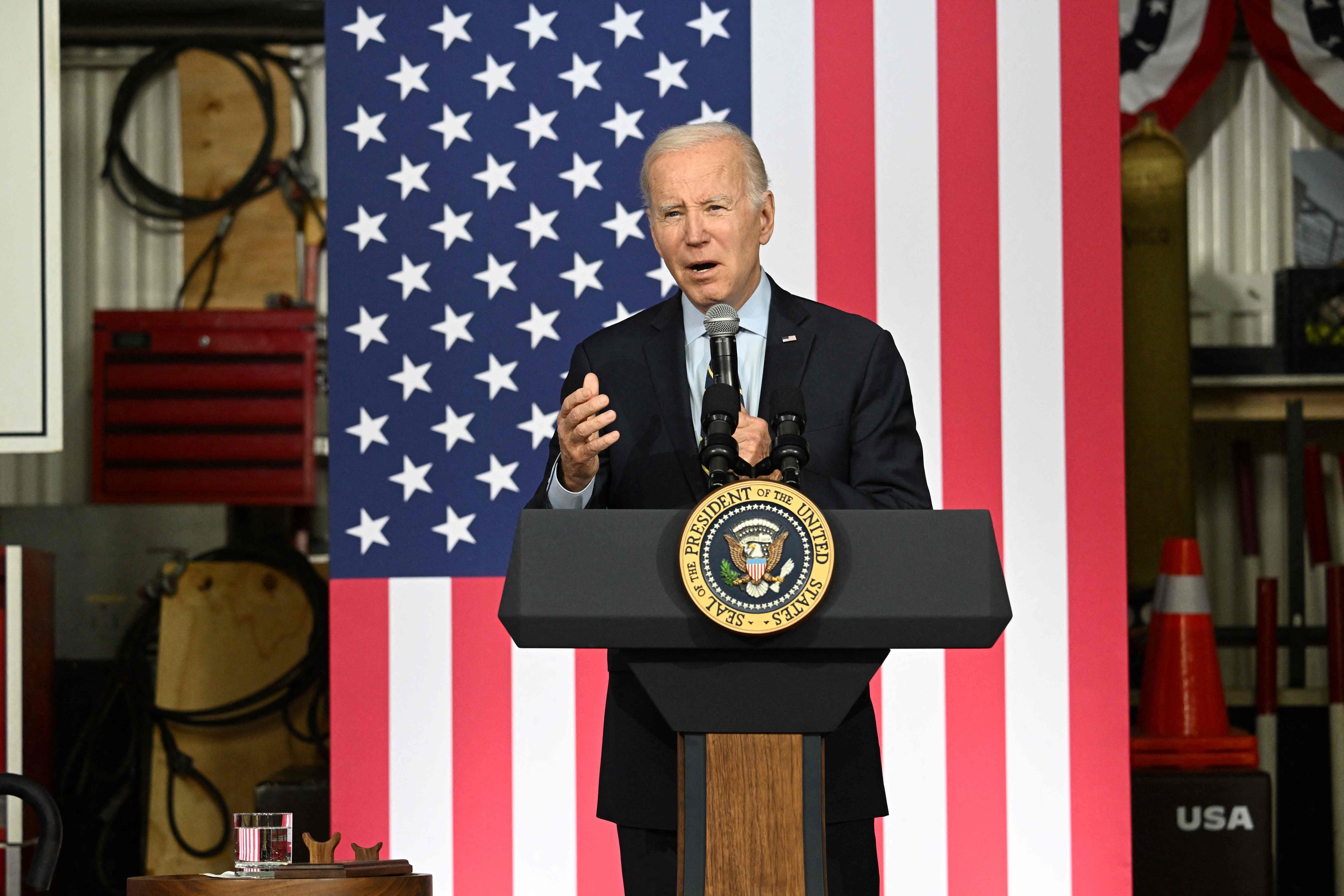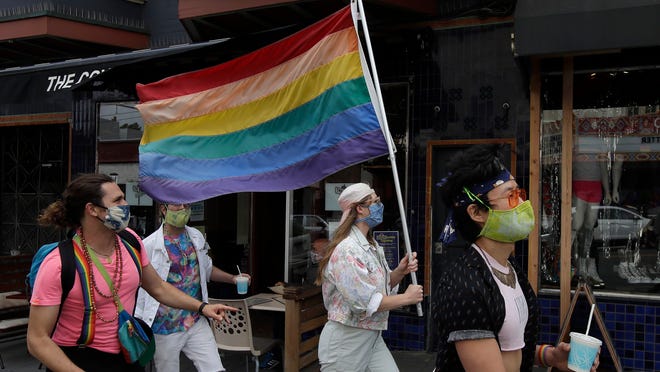

As the 2024 presidential campaign heats up, President Joe Biden is seeking to boost public confidence in the economy and build support for his efforts to raise wages and reduce consumer costs.
Polls show Biden receiving low marks from voters for his economic record amid a two-year inflation spike that has eased but remains historically high. Just 33% of adults say they approve of his handling of the economy, according to a poll last month from The Associated Press-NORC Center for Public Affairs Research.
Biden said Wednesday in a Chicago speech, in which he touted a set of policies the White House has begun referring to as "Bidenomics," that it will take time for Americans to see the effects of new laws.
"And I'm not here to declare victory on the economy," Biden declared. "I'm here to say, 'We have a plan that is turning things around incredibly quickly. But we have more work to do."
Broadly, Biden says his stimulus plan swiftly lifted the economy from the pandemic-induced recession. But critics say it went too far and helped trigger soaring inflation and rising interest rates that have the U.S. facing the prospect of another downturn.
What is Bidenomics?
Here are Biden’s main claims about his economic strategy − "Bidenomics" − and USA TODAY’s analysis of it:
Strongest recovery, lowest inflation
Biden says his policies have driven the strongest recovery among the world’s major economies and the lowest inflation. This is generally accurate, experts say.
Credit the American Rescue Plan (ARP), the $1.9 trillion COVID-19 relief package that Biden spearheaded and Congress passed in March 2021. Among other things, it doled out $1,400 stimulus checks to most households, extended generous unemployment benefits and provided more aid to small businesses.
The rescue bill – which followed $4 trillion in similar COVID-19 relief measures in 2020 – was needed because the economy was at risk of slipping back into recession, says Mark Zandi, chief economist of Moody's Analytics.
"We didn’t know how well the COVID vaccine was going to work," Zandi says. "Who knew how the pandemic was going to play out? If you have uncertainty you want to err on the side of doing too much."
Without the rescue plan, 4 million fewer jobs would have been created in 2021, Zandi estimates.
But conservative economists say the stimulus wasn’t needed because the economy was already bouncing back from the COVID-19 recession. Employers had added more than 1 million jobs during the first two months of the year, just before Congress passed the rescue package.
Meanwhile, COVID-19 vaccinations were ramping up quickly, and many consumers were resuming dining out and other activities, says Chris Edwards, senior economist at the libertarian Cato Institute. As a result, he argues, the 22 million jobs wiped out by the health crisis were poised to come back even without the massive government aid.
"It was overkill," Edwards says.
The result, he says, was a consumer spending spree that helped pushed inflation to a 40-year high of 9.1% in June 2022.
Although many economists blame COVID-19-related supply chain snarls for price run-ups across the globe, inflation was notably higher in the U.S. than in Europe in 2021. The disparity can be traced to the rescue plan, says Douglas Holtz-Eakin, president of the American Action Forum, a conservative think tank.
Zandi, however, says the plan's effect on inflation was modest. It was COVID-19’s delta variant in the summer of 2021 that intensified Asian supply troubles and drove up consumer prices, he says. Russia's war in Ukraine further disrupted supply chains and propelled commodity prices and inflation still higher.
Now, U.S. inflation, at 4%, is lower than the euro area's 6.1%, according to Trading Economics, a research firm.
Not just jobs, but good jobs
Biden’s strategy has created not only a record 13 million jobs in 2½ years but "it has created good jobs," the White House says.
Employers are offering higher pay, better benefits and more flexible schedules to attract and retain workers, a White House paper added.
The share of 25- to 54-year-olds working or looking for jobs is at 83.4%, highest since 2007, the paper noted.
Zandi agrees that the rescue package juiced consumer and business demand, forcing employers to step up hiring even as many workers retired early or left the labor force for COVID-19-related reasons. That spawned labor shortages, boosted average yearly wages by 5% and led many workers to quit jobs for better, higher-paying positions.
But Edwards says much of that sizzling labor market was rooted in the easing pandemic, not the stimulus. And he says the plan's enhanced unemployment benefits exacerbated labor shortages by giving workers an incentive not to go back to work even while job opportunities were growing.
Boosting the middle class
Biden’s policies have "helped put middle class Americans into stronger financial position than they were in pre-pandemic," the White House says. "Americans have higher net worth and higher (inflation-adjusted) disposable incomes.”
"Pay for the low-wage workers has grown at the fastest pace and over two decades," Biden said Wednesday.
According to Zandi, Americans are wealthier than they were before COVID-19 because of the sharp rise in stock and home prices early in the crisis, along with savings from several stimulus checks.
Pay increases didn't keep up with inflation for much of the pandemic, leaving low- and middle-income households struggling to keep up. But inflation-adjusted disposable income – a broader category that includes Social Security, investments and other income – is now running ahead of its pre-crisis level.
Biden also points to his sweeping legislation to invest in U.S. infrastructure, boost clean energy production, and encourage chip manufacturing in the U.S. – all of which he says will create good middle-class jobs.
And he notes that the Inflation Reduction Act lowers prescription drug costs and caps insulin prices at $35 a month for seniors, which helps middle-class Americans.
"I think Biden’s economic policies were successful in getting the economy quickly back to full employment and will be helpful in lifting its long-term competitiveness and productivity by investing in the nation’s infrastructure and incentivizing semiconductor producers to expand production in the U.S.," Zandi says.
But the more than $2 trillion in investments will swell the $32 trillion national debt and distort markets by providing subsidies to some industries over others, Edwards argues. The additional spending will mean a bigger tax burden for future generations, he says.
Zandi agrees. "The biggest failing of Biden’s fiscal policies,” he says, “is that they have added significantly to the nation’s debt load."
Recall alertHonda Odyssey, Pilot, Passport among 1.2 million vehicles recalled. Check car recalls here.
Contributing: Francesca Chambers
Source link








